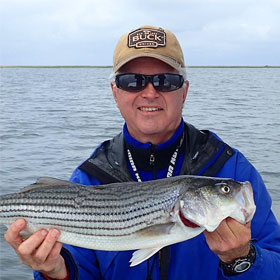The Best Size of Test Line for Bass Fishing Is….
By Ken Schultz
Jul 27, 2022
The best size of test line for bass fishing is the one that most suits the situation you’re in, what lure you’re using, and what tackle you’re casting with
Fishing is such a variable activity that anyone who spouts absolutes about the best tackle to use is full of baloney. So when someone recently asked what was the best size of test line for bass fishing, I had to unfortunately answer: it depends. Are we talking smallmouth bass or largemouth bass? Big fish or small and medium fish? In an environment where there’s a lot of obstructions or few obstructions? Using heavy lures or light ones? Baitcasting tackle or spinning? Making long casts or short ones?
There is no one-size-fits-all best fishing line test for bass. That’s one of the reasons why many hardcore bass anglers tote several (if not more) fishing outfits, each with different lures, and some equipped with different strengths (and diameters) of line. Thus, they are prepared to change what they’re using as circumstances dictate. And it’s not uncommon for those circumstances to require using all of an angler’s tools within the course of a few hours of fishing.
Let’s say, for example, that you start fishing with a small jerkbait early in the day in fairly shallow but clear water. You’d likely use a spinning outfit here, with 6- or 8-pound test monofilament line. But a little later you’re in a cove loaded with lily pads and you want to fish with a spinnerbait in more open areas or a surface frog in the matted vegetation. This dictates a stronger line, from 12- to 20-pound test perhaps if it’s a monofilament line, and maybe a thin-diameter 30 if using a braided line.
As the morning wears on, you find it necessary to work a little deeper with diving crankbaits on monofilament line and with baitcasting gear. Ten- to 14-pound test will do the job well here. You see where I’m headed? The best fishing line test for bass is the one that most suits the situation.
We can generalize a little bit about the best line test for bass fishing, however. Lighter strength lines are more suitable for smallmouth bass fishing, clear water use, long casts, and light plugs, jigs, and spinners. Heavier strength lines are more suitable for use in and around heavy cover, where big largemouths may be encountered, with baitcasting gear, and with large spinnerbaits.
Perhaps how I use multiple outfits for bass fishing can be a guide for you:
- Light hard-bodied lures like jerkbaits and minnow plugs, plus spinners and light jigs: 6- to 8-pound monofilament line on a spinning outfit.
- Crankbaits: 10- to 14-pound test monofilament on a baitcasting outfit, though up to 20-pound test might be necessary for large fish and in heavy cover.
- Surface plugs: Lighter line strengths for lighter lures, clearer water, and few obstructions; heavier strengths for bigger lures, turbid water, many obstructions. Spinning outfits for lighter lines, baitcasting for heavier line and large lures. Monofilament line for both.
- Spinnerbaits, buzz baits, heavy jigs, weighted plastic worms: 12- to 20-pound braided line, usually with a monofilament leader.









